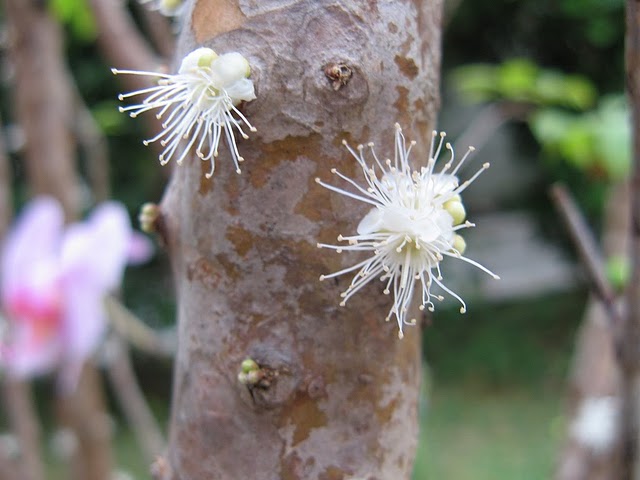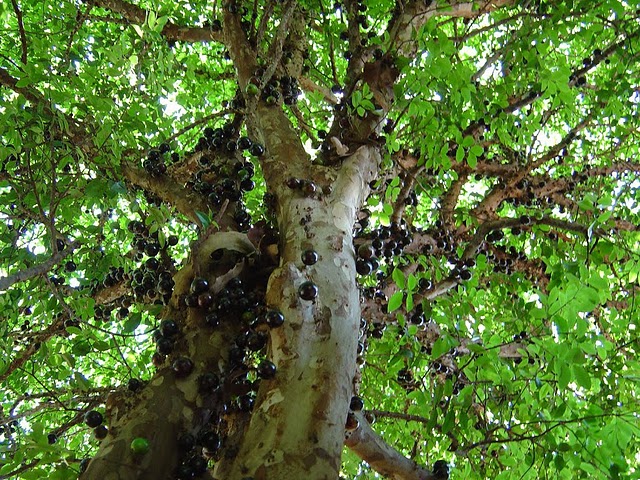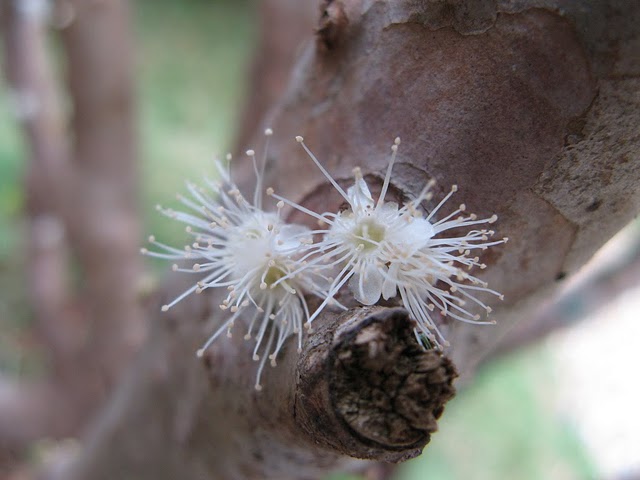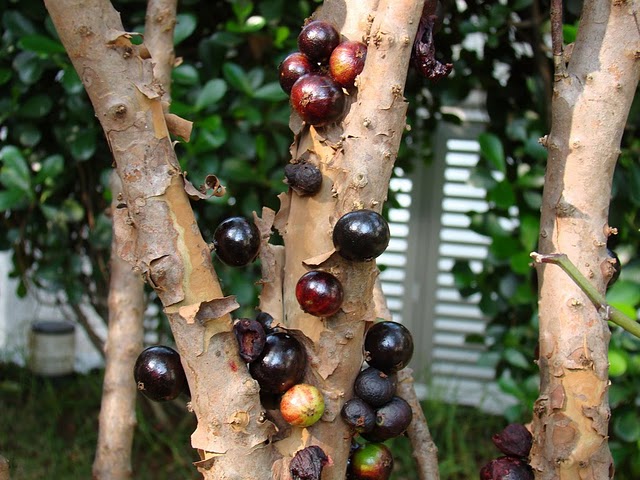The JABUTICABA tree
Sushmita Jha
|
Sushmita Jha
Well i GOOGLED it and the information seems to be true.
Its known as Myrciaria cauliflora (Mart.) O.Berg
Belongs to the Myrtaceae family.
The name is derived from the Tupi word Jabuti (tortoise) + Caba (place), meaning the place where you find tortoises.
The fruit tree (named jabuticabeira in Portuguese) has salmon-colored leaves when they are young, turning green posteriorly.
It is a very slow growing tree which prefers moist, lightly acidic soils for best growth.
It is widely adaptable, however, and grows satisfactorily even on alkaline beach-sand type soils, so long as they are tended and irrigated.
Its flowers are white and grow directly from its trunk in a cauliflorous habit.
Naturally, the tree may flower and fruit only once or twice a year, but when continuously irrigated it flowers frequently, and fresh fruit can be available year round in tropical regions.
It’s a small tree native to Minas Gerais in southeastern Brazil, grown for its purple grape-like fruits it produces.
It has a thick, purple, astringent skin that covers a sweet, white, or rosy pink gelatinous flesh. Common in Brazilian markets
Jaboticabas are largely eaten fresh; their popularity has been likened to that of grapes in the US.
-----
USES
Traditionally, an astringent decoction of the sun-dried skins has been used as a treatment for hemoptysis, asthma, diarrhea, and gargled for chronic inflammation of the tonsils. The fruit is 3-4 cm in diameter with one to four large seeds, borne directly on the main trunks and branches of the plant, lending a distinctive appearance to the fruiting tree.
Fresh fruit may begin to ferment 3 to 4 days after harvest, so they are often used to make jams, tarts, strong wines, and liqueurs.
Several potent antioxidant and anti-inflammatory anti-cancer compounds have been isolated from the fruit. One that is unique to the fruit is jaboticabin.
OTHERS
Also known as Eugenia cauliflora.
jabuticaba - for the fruit (jaboticabeira for the tree) actually embrace 4 species of very similar trees and fruits.
More details are available at http://www.crfg.org/pubs/ff/jaboticaba.html
Regards,
Shweta
--
Bhatt ShwetaAsso. Prof.,TCSC,Doctoral Research Student,M.S.U.
Anand Kumar Bhatt
Anand Kumar Bhatt
A-59, B.S.F.Colony, Airport Road
Gwalior. 474 005.
Tele: 0751-247 2233. Mobile 0 94253 09780.
My blogsite is at:
http://anandkbhatt.blogspot.com
(A NEW BLOG HAS BEEN ADDED ON 29 jJanuary 2011.)
And the photo site:
www.flickr.com/photos/akbhatt/
~~~~~~~~~~~~~~~
Ten most common surnames of Indians: Singh, Kumar, Sharma, Patel, Shah, Lal, Gupta, Bhat, Rao, Reddy. Cheers!
hari lal
moraceae same as ficus infectoria or ficus glomerata
hari shankar lal
On 3/1/11, Anand Kumar Bhatt <anand...@gmail.com> wrote:
> Very informative. Thank you.
> Gullar and Kathal also fruit in the same way.
> ak
>
> On Tue, Mar 1, 2011 at 11:51 AM, Sushmita Jha <sushmi...@gmail.com>wrote:
>
>> Thank you so much, Sweta. Really appreciate your prompt help.
>> Sushmita
>>
>> On Tue, Mar 1, 2011 at 11:43 AM, Bhatt Sweta <bhatt...@gmail.com> wrote:
>>
>>> Well i *GOOGLED* it and the information seems to be true.
>>>
>>> Its known as* Myrciaria cauliflora* (Mart.) O.Berg
>>>
>>> Belongs to the Myrtaceae family.
>>>
>>> The name is derived from the Tupi word *Jabuti* (tortoise) +
>>> *Caba*(place), meaning the place where you find tortoises.
>>>
>>> The fruit tree (*named jabuticabeira in Portuguese*) has salmon-colored
>>> leaves when they are young, turning green posteriorly.
>>>
>>> It is a very slow growing tree which prefers moist, lightly acidic soils
>>> for best growth.
>>>
>>> It is widely adaptable, however, and grows satisfactorily even on
>>> alkaline
>>> beach-sand type soils, so long as they are tended and irrigated.
>>>
>>> Its flowers are white and grow directly from its trunk in a cauliflorous
>>> habit.
>>>
>>> Naturally, the tree may flower and fruit only once or twice a year, but
>>> when continuously irrigated it flowers frequently, and fresh fruit can be
>>> available year round in tropical regions.
>>>
>>> It’s a small tree native to Minas Gerais in southeastern Brazil, grown
>>> for
>>> its purple grape-like fruits it produces.
>>>
>>> It has a thick, purple, astringent skin that covers a sweet, white, or
>>> rosy pink gelatinous flesh. Common in Brazilian markets
>>>
>>> Jaboticabas are largely eaten fresh; their popularity has been likened to
>>> that of grapes in the US.
>>>
>>>
>>> -----
>>>
>>> *USES*
>>>
>>> Traditionally, an astringent decoction of the sun-dried skins has been
>>> used as a treatment for hemoptysis, asthma, diarrhea, and gargled for
>>> chronic inflammation of the tonsils. The fruit is 3-4 cm in diameter with
>>> one to four large seeds, borne directly on the main trunks and branches
>>> of
>>> the plant, lending a distinctive appearance to the fruiting tree.
>>>
>>> Fresh fruit may begin to ferment 3 to 4 days after harvest, so they are
>>> often used to make jams, tarts, strong wines, and liqueurs.
>>>
>>> Several potent antioxidant and anti-inflammatory anti-cancer compounds
>>> have been isolated from the fruit. One that is unique to the fruit is
>>> jaboticabin.
>>>
>>> *OTHERS*
>>> Also known as *Eugenia cauliflora*.
>>>
>>> jabuticaba - for the fruit (jaboticabeira for the tree) actually
>>> embrace*4 species of very similar trees and fruits.
>>> *
>>>
>>> More details are available at *
>>> http://www.crfg.org/pubs/ff/jaboticaba.html*
>>>
>>> Regards,
>>> Shweta
>>>
>>>
>>> On Tue, Mar 1, 2011 at 11:29 AM, Sushmita Jha
>>> <sushmi...@gmail.com>wrote:
>>>
>>>> Hello all,
>>>> sharing a forward I have received. I have not done any research to
>>>> verify
>>>> this. Strange forwards do come our way. It will be great to know from
>>>> experts whether this is real.
>>>> Thank you.
>>>> Sushmita Jha
>>>>
>>>>
>>>>
>>>> Jabuticaba ?
>>>> The Tree that Fruits on its Trunk
>>>>
>>>>
>>>> No, this is not a belated April Fool?s prank. They look as if they may
>>>> have been pinned there by an overenthusiastic gardener to impress the
>>>> neighbors, but the fruit of the Jabuticaba really does grow off the
>>>> trunk of
>>>> the tree.
>>>> Otherwise known as the Brazilian Grape Tree, this plant is native to
>>>> South America, notably Paraguay , Argentina and (obviously from its
>>>> name)
>>>> mostly from Brazil . The fruit, a succulent looking purple color, can
>>>> be
>>>> plucked and eaten straight from the tree.
>>>>
>>>> It is also a popular ingredient in jellies and is also juiced to make
>>>> a refreshing summer drink. What is more, it can be fermented and made
>>>> into
>>>> wine and strong liquor. After three days off the tree the fermentation
>>>> will
>>>> begin, so sometimes, there is no choice; honestly.
>>>>
>>>> If you want one of these in your garden, then you have to be patient.
>>>> The tree takes an age to grow, but once it reaches maturity it is worth
>>>> it.
>>>> However, it has proven to be very adaptable and, although it prefers
>>>> moist
>>>> and slightly acid soils, it will even grow well in an alkaline type
>>>> soil.
>>>>
>>>>
>>>>
>>>> The flowers themselves appear on the tree at most twice a year ? *
>>>> naturally*. They look like some strange alien creature that has
>>>> deposited itself on the trunk and branches. The habit of flowers doing
>>>> this
>>>> makes them cauliflorous. Instead of growing new shoots, these plants
>>>> flower
>>>> direct from the woody trunk or stem.
>>>>
>>>>
>>>> You might ask why it is this way. The simple answer is that it has
>>>> evolved in this manner so that animals that cannot climb very high can
>>>> reach
>>>> it, eat it and then expel the seeds away from the parent tree to further
>>>> propagate the species.
>>>>
>>>>
>>>> If the tree is well irrigated then it will flower and fruit all the
>>>> year round. The fruit itself is about four centimeters in diameter and
>>>> has
>>>> up to four large seeds. As well as being used as food, the skins can be
>>>> dried out and used to treat asthma and diarrhea.
>>>>
>>>> If your tonsils are swollen you can also use it to try and alleviate
>>>> the inflammation. It is also hoped that the tree will be useful in the
>>>> fight against cancer, as several anti-cancer compounds have been found
>>>> in
>>>> the fruit.
>>>>
>>>> Altogether a useful tree, if a slightly strange looking one
>>>> __,_._,_
>>>>
>>>>
>>>>
>>>>
>>>>
>>>
>>>
>>> --
>>> *Bhatt Shweta*
>>> *Asso. Prof.,*
>>> TCSC,
>>> *Doctoral Research Student,*
>>> M.S.U.
>>>
>>>
>>
>
>
> --
> Anand Kumar Bhatt
> A-59, B.S.F.Colony, Airport Road
> Gwalior. 474 005.
> Tele: 0751-247 2233. Mobile 0 94253 09780.
> My blogsite is at:
> http://anandkbhatt.blogspot.com
> (A NEW BLOG HAS BEEN ADDED ON 29 jJanuary 2011.)
> And the photo site:
> www.flickr.com/photos/akbhatt/
> <http://www.flickr.com/photos/akbhatt/>(NEW PHOTOS HAVE BEEN ADDED ON 24 FEB
Dr Pankaj Kumar
Thanks a lot for sharing the pics and information. A nice piece of
research it seems.
Myrciaria cauliflora as the name suggests cauliflora means "flowering
on the stem".
Regards
Pankaj
On Mar 1, 7:04 pm, hari lal <taxo....@gmail.com> wrote:
> very interesting Sushmita jee i think this belong to the family
> moraceae same as ficus infectoria or ficus glomerata
> hari shankar lal
>
>
>
>
>
>
>
>
> > Very informative. Thank you.
> > Gullar and Kathal also fruit in the same way.
> > ak
>
>
> >> Thank you so much, Sweta. Really appreciate your prompt help.
> >> Sushmita
>
Neo
On Feb 28, 9:59 pm, Sushmita Jha <sushmitas...@gmail.com> wrote:
> Hello all,
> sharing a forward I have received. I have not done any research to verify
> this. Strange forwards do come our way. It will be great to know from
> experts whether this is real.
> Thank you.
> Sushmita Jha
>
> Jabuticaba ?
> The Tree that Fruits on its Trunk
>
> been pinned there by an overenthusiastic gardener to impress the neighbors,
> but the fruit of the Jabuticaba really does grow off the trunk of the tree.
> America, notably Paraguay , Argentina and (obviously from its name)
> mostly from Brazil . The fruit, a succulent looking purple color, can be
> plucked and eaten straight from the tree.
>
> refreshing summer drink. What is more, it can be fermented and made into
> wine and strong liquor. After three days off the tree the fermentation will
> begin, so sometimes, there is no choice; honestly.
>
> tree takes an age to grow, but once it reaches maturity it is worth it.
> However, it has proven to be very adaptable and, although it prefers moist
> and slightly acid soils, it will even grow well in an alkaline type soil.
>
> *. They look like some strange alien creature that has deposited itself on
> cauliflorous. Instead of growing new shoots, these plants flower direct from
> the woody trunk or stem.
>
> in this manner so that animals that cannot climb very high can reach it, eat
> it and then expel the seeds away from the parent tree to further propagate
> the species.
>
> round. The fruit itself is about four centimeters in diameter and has up to
> four large seeds. As well as being used as food, the skins can be dried out
> and used to treat asthma and diarrhea.
>
> inflammation. It is also hoped that the tree will be useful in the fight
> against cancer, as several anti-cancer compounds have been found in the
> fruit.
>
> Altogether a useful tree, if a slightly strange looking one
> __,_._,_
>
> 66KViewDownload
>
> ATT00003.jpeg
> 87KViewDownload
>
> ATT00010.jpeg
> 147KViewDownload
>
> ATT00007.jpeg
> 63KViewDownload
>
> ATT00004.jpeg
> 230KViewDownload
>
> ATT00002.jpeg
> 135KViewDownload
>
> ATT00008.jpeg
> 222KViewDownload
>
> ATT00005.jpeg
> 120KViewDownload
>
> ATT00009.jpeg
> 91KViewDownload
>
> ATT00001.jpeg
> 116KViewDownload
manudev madhavan
Centre for Postgraduate Studies & Research
St. Joseph's College, Devagiri
Kozhikode- 673 008
Mob: 9496470738
J.M. Garg
Forwarding again for Id confirmation or otherwise please.
Some earlier relevant feedback:
“Well i GOOGLEDit and the information seems to be true.
moraceae same as ficus infectoria or ficus glomerata
hari shankar lal”
research it seems.
Myrciaria cauliflora as the name suggests cauliflora means "flowering
on the stem".
Pankaj"
“Appears to belong to the Flacourtia genus. May be Flacourtia jangomas” from Neo ji.
The whole world uses my Image Resource of more than a thousand species & eight thousand images of Birds, Butterflies, Plants etc. (arranged alphabetically & place-wise): http://commons.wikimedia.org/wiki/Category:J.M.Garg. You can also use them for free as per Creative Commons license attached with each image.
Ushadi micromini
YES THIS IS JABOTICABA... a cauliflori tree from Brazil...
called * Myriciaria cauliflora*
I will send a new post with my pictures, from a botanical garden
started by a physician in California...
I was not there when the tree flowered but have seen , photographed
and tasted fruits of this tree elsewhere,
somewhat sweet..
Usha di
=====
On Jun 16, 10:34 am, "J.M. Garg" <jmga...@gmail.com> wrote:
> Forwarding again for Id confirmation or otherwise please.
>
> Some earlier relevant feedback:
>
> “Well i GOOGLEDit and the information seems to be true.
>
> “very interesting Sushmita jee *i think this belong to the family
> moraceae* same as ficus infectoria or ficus glomerata
>
> "Thanks a lot for sharing the pics and information. A nice piece of
> research it seems.
> Regards
> Pankaj"
>
>
> ---------- Forwarded message ----------
> From: Sushmita Jha <sushmitas...@gmail.com>
> Date: 1 March 2011 11:29
> Subject: [efloraofindia:63856] The JABUTICABA tree
> To: indiantreepix <indian...@googlegroups.com>
>
> Hello all,
> sharing a forward I have received. I have not done any research to verify
> this. Strange forwards do come our way. It will be great to know from
> experts whether this is real.
> Thank you.
> Sushmita Jha
>
> Jabuticaba ?
> The Tree that Fruits on its Trunk
>
> been pinned there by an overenthusiastic gardener to impress the neighbors,
> but the fruit of the Jabuticaba really does grow off the trunk of the tree.
> America, notably Paraguay , Argentina and (obviously from its name)
> mostly from Brazil . The fruit, a succulent looking purple color, can be
> plucked and eaten straight from the tree.
>
> refreshing summer drink. What is more, it can be fermented and made into
> wine and strong liquor. After three days off the tree the fermentation will
> begin, so sometimes, there is no choice; honestly.
>
> tree takes an age to grow, but once it reaches maturity it is worth it.
> However, it has proven to be very adaptable and, although it prefers moist
> and slightly acid soils, it will even grow well in an alkaline type soil.
>
> *. They look like some strange alien creature that has deposited itself on
> cauliflorous. Instead of growing new shoots, these plants flower direct from
> the woody trunk or stem.
>
> in this manner so that animals that cannot climb very high can reach it, eat
> it and then expel the seeds away from the parent tree to further propagate
> the species.
>
> round. The fruit itself is about four centimeters in diameter and has up to
> four large seeds. As well as being used as food, the skins can be dried out
> and used to treat asthma and diarrhea.
>
> inflammation. It is also hoped that the tree will be useful in the fight
> against cancer, as several anti-cancer compounds have been found in the
> fruit.
>
> Altogether a useful tree, if a slightly strange looking one
> __,_._,_
>
> --
> With regards,
> alphabetically & place-wise):http://commons.wikimedia.org/wiki/Category:J.M.Garg. You can also use them
> for free as per Creative Commons license attached with each image.
> For identification, learning, discussion & documentation of Indian Flora,
> 70,000 messages on 30/5/11) or Efloraofindia website:https://sites.google.com/site/efloraofindia/(with a species database of
> around 5000 species)
>
>
>
> ATT00010.jpeg
> 147KViewDownload
>
> ATT00005.jpeg
> 120KViewDownload
>
> ATT00006.jpeg
> 66KViewDownload
>
> ATT00004.jpeg
> 230KViewDownload
>
> ATT00008.jpeg
> 222KViewDownload
>
> ATT00007.jpeg
> 63KViewDownload
>
> ATT00002.jpeg
> 135KViewDownload
>
> ATT00009.jpeg
> 91KViewDownload
>
> ATT00003.jpeg
> 87KViewDownload
>
> ATT00001.jpeg
> 116KViewDownload
Ushadi micromini
come to think of it....
MANY trees set flowers and fruits on its trunk directly....
some that come to mind right here are:
Cocoa or Theobroma cacao
Jackfruit or kathal or Artocarpus heterophyllus
Calabash or Crescentia cujete
Cannonball tree or Couroupita guianensis
Devphal or Artocarpus gomezianus Wall. ex Trécul
and this... Jaboticaba... or Myrciara cauliflora....
Usha di
=============
>
> Some earlier relevant feedback:
>
> “Well i GOOGLEDit and the information seems to be true.
>
> “very interesting Sushmita jee *i think this belong to the family
> moraceae* same as ficus infectoria or ficus glomerata
>
> "Thanks a lot for sharing the pics and information. A nice piece of
> research it seems.
> Regards
> Pankaj"
>
>
> ---------- Forwarded message ----------
> From: Sushmita Jha <sushmitas...@gmail.com>
> Date: 1 March 2011 11:29
> Subject: [efloraofindia:63856] The JABUTICABA tree
> To: indiantreepix <indian...@googlegroups.com>
>
> Hello all,
> sharing a forward I have received. I have not done any research to verify
> this. Strange forwards do come our way. It will be great to know from
> experts whether this is real.
> Thank you.
> Sushmita Jha
>
> Jabuticaba ?
> The Tree that Fruits on its Trunk
>
> been pinned there by an overenthusiastic gardener to impress the neighbors,
> but the fruit of the Jabuticaba really does grow off the trunk of the tree.
> America, notably Paraguay , Argentina and (obviously from its name)
> mostly from Brazil . The fruit, a succulent looking purple color, can be
> plucked and eaten straight from the tree.
>
> refreshing summer drink. What is more, it can be fermented and made into
> wine and strong liquor. After three days off the tree the fermentation will
> begin, so sometimes, there is no choice; honestly.
>
> tree takes an age to grow, but once it reaches maturity it is worth it.
> However, it has proven to be very adaptable and, although it prefers moist
> and slightly acid soils, it will even grow well in an alkaline type soil.
>
> *. They look like some strange alien creature that has deposited itself on
> cauliflorous. Instead of growing new shoots, these plants flower direct from
> the woody trunk or stem.
>
> in this manner so that animals that cannot climb very high can reach it, eat
> it and then expel the seeds away from the parent tree to further propagate
> the species.
>
> round. The fruit itself is about four centimeters in diameter and has up to
> four large seeds. As well as being used as food, the skins can be dried out
> and used to treat asthma and diarrhea.
>
> inflammation. It is also hoped that the tree will be useful in the fight
> against cancer, as several anti-cancer compounds have been found in the
> fruit.
>
> Altogether a useful tree, if a slightly strange looking one
> __,_._,_
>
> --
> With regards,
> alphabetically & place-wise):http://commons.wikimedia.org/wiki/Category:J.M.Garg. You can also use them
> for free as per Creative Commons license attached with each image.
> For identification, learning, discussion & documentation of Indian Flora,
> 70,000 messages on 30/5/11) or Efloraofindia website:https://sites.google.com/site/efloraofindia/(with a species database of
> around 5000 species)
>
>
>










